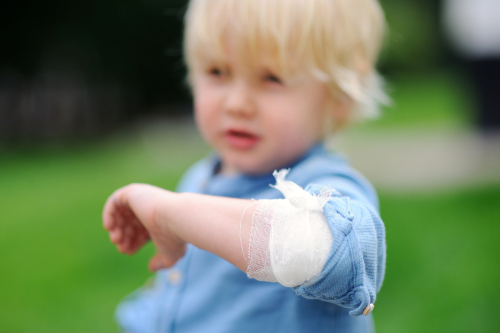DAAC Dressing Closes EB Wounds Faster Than Standard Saline-Antibiotic One, Study Says
Written by |

A type of wound dressing, called dialkylcarbamoylchloride (DAAC)‐coated cotton acetate, closes infected wounds related to epidermolysis bullosa (EB) faster than the standard saline dressing plus a topic antibiotic, and with similar antibacterial effects, a study found.
The study, “Clinical efficacy of dialkyl-carbamoyl chloride‐coated cotton acetate dressing versus combination of normal saline dressing and 2% mupirocin ointment in infected wounds of epidermolysis bullosa,” was published in the journal Dermatologic Therapy.
Bacterial infection of wounds caused by EB can delay the healing process and repeat infection can make wounds chronic. No guidelines now exist for wound care in EB, which also complicates treatment.
Normal saline dressing combined with a topical antibiotic, such as mupirocin, is the most common treatment today. Such antibiotics kill the bacteria, and the saline solution cleans the wound.
DAAC‐coated cotton acetate dressing is an alternative treatment for infected wounds. DDAC is a synthetic fatty acid that catches the bacteria and prevents them from reproducing, while maintaining a healing environment around the wound.
Since it is not an antibiotic, DDAC has no risk of generating resistance or introducing chemicals through the wound, the study notes. It also reduces the risk of skin staining.
Researchers in Indonesia performed a controlled study to compare the efficacy of a normal saline and mupirocin combination to that of DDAC-coated dressing on infected EB wounds.
They evaluated 14 wounds in five patients, ages 11 to 20, diagnosed with dystrophic EB. Half of the wounds were treated with a DDAC dressing that was changed every three days, and the other half with saline and mupirocin applied three times a day.
Patients did not use any systemic antibiotic during the study, and wounds were checked every three days for the presence of bacteria and to evaluate the healing process.
After three days, both treatments had killed the bacteria. At this point, mupirocin use was stopped, and care in this group of wounds continued with saline dressing only. At day six, both wound groups showed improvement, suggesting that both treatments have a similar antibacterial effect.
While both dressings were free of bacteria by day three, and achieved clinical improvement of skin infection by day six, the wounds in the DDAC group healed in significantly less time than those in the mupirocin group (8.6 vs. 11.4 days, on average).
“This is a novel study in EB infected wounds shows that DACC-coated cotton acetate dressing promotes faster wound closure and is as effective as a combination of normal saline dressing and 2% mupirocin ointment in eliminating the bacterial infection,” the investigators said.
They added that DDAC is also more practical and does not induce mechanical damage to the skin, and that since “DACC-coated cotton acetate dressing does not need to be changed several times a day … it can improve patient’s compliance.”
“Based on these results, DACC-coated cotton acetate dressing can be used as an alternative for infected wounds without the risk of bacterial resistance,” the researchers concluded.





